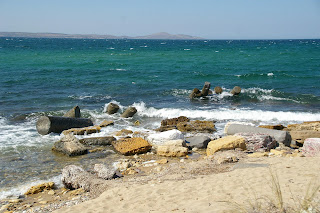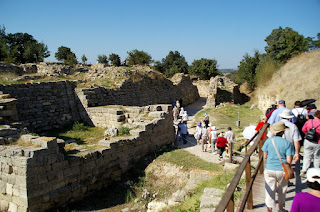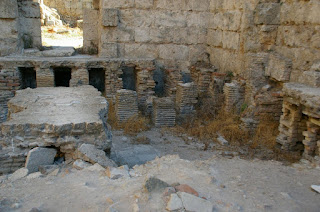
A trip to Turkey would not be complete without a visit to Gallipoli.
We left by boat ferry early in the morning to travel the few km from Cannakale to Gallipoli. I can't tell you how moving it was to stand on the hill above Anzac Cove and look down on that beautifully clear water and white sand. It was a scene of such peace yet the scene of terrible and unnecessary horror.
Even more moving was to walk into the small cemetery nearby where a hundred or so Australians are buried. To see graves of young men of 17 or 18, or men who are named as only sons left us in tears and lost for words.

The cemetery was small only because most of the fallen were left where they were, not to be buried until after the war when Commonwealth forces joined with the Turkish government to build the cemeteries as memorials. Most of the 8,500 Australians(!) who died there in just a few months are named as either buried in umnmarked graves or simply lost. The list at Lone Pine is extensive.
We were also reminded that the loss was on both sides as we visited the Turkish cemetery where no-one had a date of birth, just the year of birth and the town they came from. The curent Lone Pine was grown from a seed brought from Australia, possibly form the tree in Wattle Park that was grown from a seed brought back after 1915.

There we saw a statue to the gallant Turkish soldiers, led by Kamal Ataturk, who held off the British & Anzac forces until reinforcements arrived. There was also the statue of a 110 year old Turkish Veteran who visited the cemetery with his great great great granddaughter on the 85th anniversay of the Gallipoli campaign.
There are many stories told of the kindness shown by both Anzac and Turkish soldiers to those on the other side. One of the most moving stories is depicted in the statue here. During one of the ceasefires called to bring injured soldiers back to be cared for, an Australian soldier was left far from the Aussie trenches. A Turkish soldier tied his white T-shirt to his rifle and went out to pick up the injured man and carried hm across the battle ground to the Australian Trench. There were other stories involving sharing of magazines and tobacco that I can tell you when I get back.
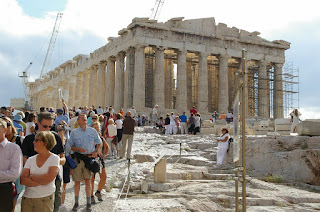

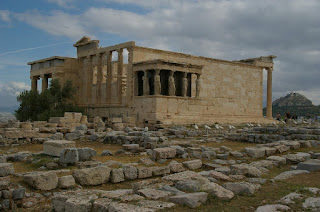
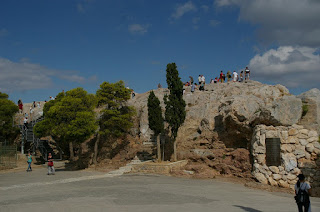
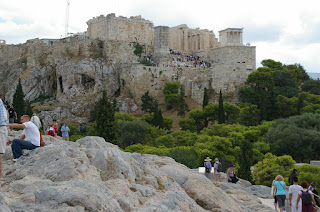







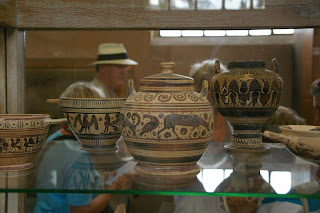
 We also saw the Bema or Judgment Seat where Gallio ruled that the Jews had no case against Paul for preaching Jesus Christ (Acts 18:12-16). An inscription we saw in Delphi dates this event at 52AD.
We also saw the Bema or Judgment Seat where Gallio ruled that the Jews had no case against Paul for preaching Jesus Christ (Acts 18:12-16). An inscription we saw in Delphi dates this event at 52AD.

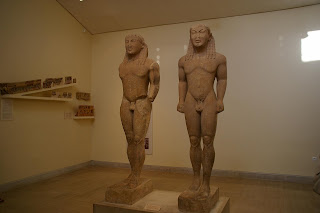


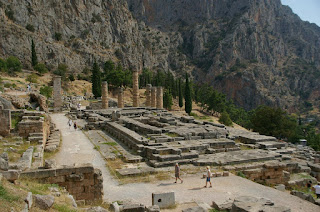





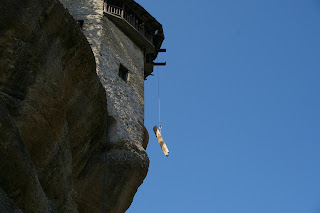
 Being Sunday our first stop was at a church. The Basilica of St Demetri was built in the 4th Century on the site of the old Roman Baths where Demetri had been martyred and buried for his Christian Faith.
Being Sunday our first stop was at a church. The Basilica of St Demetri was built in the 4th Century on the site of the old Roman Baths where Demetri had been martyred and buried for his Christian Faith. 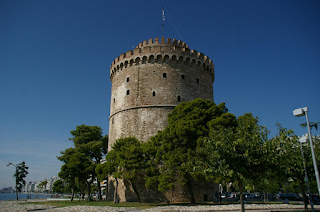


 Then it was on to Beroea, the only city mentioned in Acts where Paul wasn't thrown out of the synagogue, but instead they studied the Scriptures carefully to see if what he said was true. The Bema (Podium - the thrtee steps in the centre) where he preached the gospel to the population is commemorated in a mosaic decorated shrine.
Then it was on to Beroea, the only city mentioned in Acts where Paul wasn't thrown out of the synagogue, but instead they studied the Scriptures carefully to see if what he said was true. The Bema (Podium - the thrtee steps in the centre) where he preached the gospel to the population is commemorated in a mosaic decorated shrine. From there it was on to Vergina, the best archeological site yet, though unfortunately we weren't allowed to take photos so all you can see is the place we had lunch! At Vergina a Greek archeologist had noticed a large mound (14metres high) in the middle of the town that looked like a burial mound - what we would call a Barrow, but the Greeks call a Tumulus. So he decided to explore it and slowly uncovered a large cemetery with many graves that had been broken up by grave robbers. Eventually though they came across two untouched and sealed burial chambers built in stone, one 9.5m by 4m, the otehr 6.5X4m. They discovered that these contained the remains of King Philp II of Greece and probably the 15 year old Alexander IV who was assassinated, along with an amazing collection of belongings buried with them including stunning gold wreaths fashioned like oak leaves and acorns.
From there it was on to Vergina, the best archeological site yet, though unfortunately we weren't allowed to take photos so all you can see is the place we had lunch! At Vergina a Greek archeologist had noticed a large mound (14metres high) in the middle of the town that looked like a burial mound - what we would call a Barrow, but the Greeks call a Tumulus. So he decided to explore it and slowly uncovered a large cemetery with many graves that had been broken up by grave robbers. Eventually though they came across two untouched and sealed burial chambers built in stone, one 9.5m by 4m, the otehr 6.5X4m. They discovered that these contained the remains of King Philp II of Greece and probably the 15 year old Alexander IV who was assassinated, along with an amazing collection of belongings buried with them including stunning gold wreaths fashioned like oak leaves and acorns.





 A trip to Turkey would not be complete without a visit to Gallipoli.
A trip to Turkey would not be complete without a visit to Gallipoli. The cemetery was small only because most of the fallen were left where they were, not to be buried until after the war when Commonwealth forces joined with the Turkish government to build the cemeteries as memorials. Most of the 8,500 Australians(!) who died there in just a few months are named as either buried in umnmarked graves or simply lost. The list at Lone Pine is extensive.
The cemetery was small only because most of the fallen were left where they were, not to be buried until after the war when Commonwealth forces joined with the Turkish government to build the cemeteries as memorials. Most of the 8,500 Australians(!) who died there in just a few months are named as either buried in umnmarked graves or simply lost. The list at Lone Pine is extensive.

